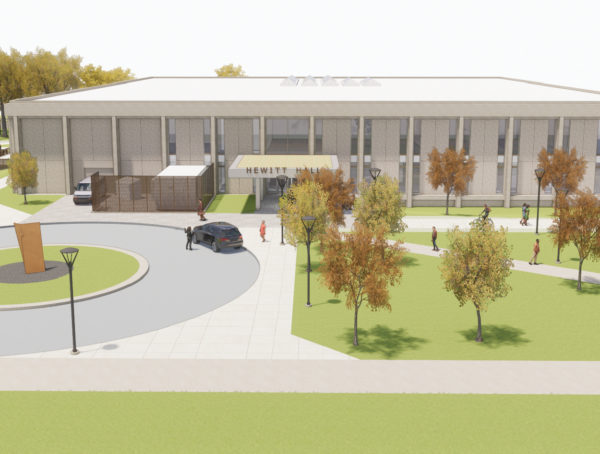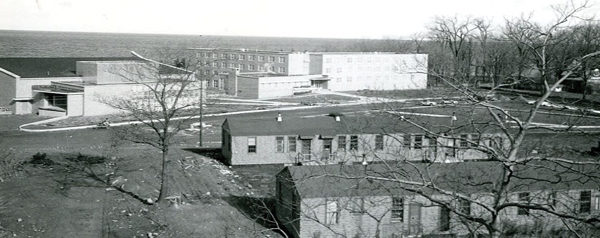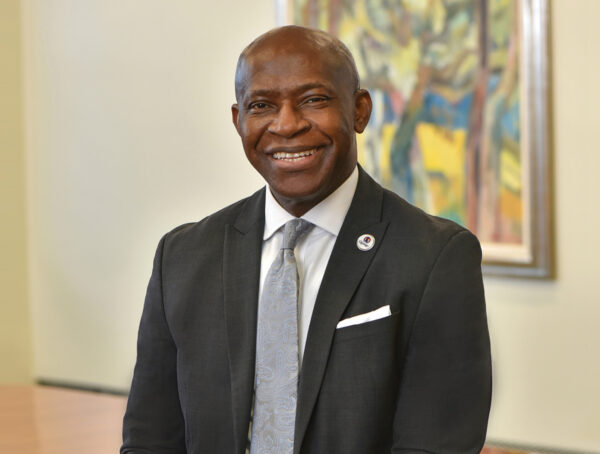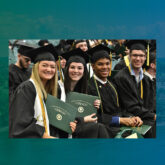They’ve been called “The Greatest Generation.” When duty called, they put their lives on hold to defend freedom across the world. They are the wartime classes and they are a very special part of Oswego’s history.
When they entered in the fall of 1941, the Class of 1945 numbered 100 strong — the largest freshman class in the history of the Normal School. They spent a carefree autumn settling into local rooming houses, working hard in class, enjoying dances and flirting with members of the opposite sex.
Then came Dec. 7, 1941, and their world turned upside down.
“Everything changed when we came out of the movie theatre Dec. 7,” said
Denham Griffin ’47. The Japanese had bombed Pearl Harbor.
“First thing we asked was, ‘Where is Pearl Harbor?’” Denham said with a chuckle. “We didn’t have Mrs. [Isabel Kingsbury 1907] Hart’s geography course yet.”
They would learn where Pearl Harbor was all too quickly, and over the course of the next four years many more names as well: Omaha Beach, Guadalcanal, Iwo Jima.
By the time 1945 rolled around most of the men were still in uniform. The graduating class was less than half of its original number, and mostly female. Only 41 would march across the stage in Sheldon Hall, rebuilt from a devastating fire in January 1941. The men would return as veterans, however, and go on to graduate in 1947, 1948 and 1949. Even today, reunions include members of classes from 1940 to 1949, many married to each other.
Calm Before the Storm
All that turmoil was just a blip on the horizon as the Class of 1945 got off the train or bus to begin their undergraduate adventure.
“The railroad came into Oswego at that point and it was a nice day,” said
Denham Griffin. “The nice taxi cab driver said he had a good room for us, so my buddy and I said, ‘We’ll look at it.’”
At that time most students lived in private homes, three or four to a
room. Thanks to that cabbie’s advice, Denham and his friend the late Tom Richardson ’46 (who would become president of New Jersey’s Montclair State University) landed the jackpot — single rooms for $3 a week. “We were very pleased,” he added. Even after $3 a week for a supper meal at Herbie’s Diner, that left them plenty of money for books . . . and courting the girls.
Sylvia Norton Griffin ’47 lived during freshman year in Dubuque’s house, along with seven other girls, and worked to pay for her room and board. Later she would live in the Chetney house. “They had 20 girls, but only one bathroom. The tub was in a separate room,” she recalled.
Liz Grieve Leal ’45 lived in Shady Shore with President Ralph and Mrs. Alice Swetman. She did odd chores around the house for her room and board. “I was a ‘handy helper’ . . . I got Dr. Swetman’s breakfast and made Mrs. Swetman’s coffee and took it up to her. She liked to stay in bed and practice bridge hands.”
After finding a place to live, the frosh had to go through orientation. “One of the upperclassmen would write you a letter before school opened and he was your big brother and he explained what to expect,” said Ernie Leal ’47.
At that time freshmen orientation was a little different than today’s version.
“They used to hit you with paddles,” said Ernie, referring to the playful tradition. “And you had to wear an Oswego beanie and you had to sing all four stanzas of ‘O Blue are Ontario’s Waters.’”
In Uniform
Shortly after Pearl Harbor, Oswego students began enlisting in the armed forces. Throughout the war, they would leave, some never to return.
“A number from our class were killed, and there was no one to help us with that,” remembered Norma Sutherland Church ’45. “Three men I dated were part of that.”
Others spent years in the service,
returning to Oswego when discharged. Bill Gallik ’47 was in the original class of “60-Day Wonders.” He received his commission at Notre Dame University. “They decided we weren’t so wonderful — they gave us two more months.” He would serve on Chichi Jima and Guam. “I was on board a ship for 10 months before I
became commanding officer.”
Ernie Leal had to wait a bit. “A lot of fellows enlisted right after Pearl Harbor, but I was 18 and you had to be 21, and my parents wouldn’t let me.” He would enter the reserves for a six-month stint in the fall of 1942 and be shipped
right out.
Davis Parker ’47 signed up in 1943 and was trained as a weatherman. He spent two years in New Guinea before finishing his schooling. After he returned he would move to the Rochester area, where he met and married his wife of nearly 61 years, Jane.
President Ralph W. Swetman and other professors wrote frequent letters to student-servicemen abroad. Dave Parker remembers the librarian Mary Hennessey writing to him. One letter from Swetman, dated Aug. 15, 1945, filled the guys in on the annual summer session at Shady Shore: “We had a wonderful evening at the traditional weiner roast last night. The swimming was perfect, the hot dogs were still hot dogs (with the inevitable indigestion), but the community singing which followed was really good — with the best in barber shop harmonies.”
Swetman concluded, “Even as this letter is being written, the thrilling news
of the Russian entry into the war, the atomic bomb and the Japanese peace
feelers, is coming over the radio. It will not be long now. When you fellows all get back, this college will hum as never before.”
Those boys who were lucky enough to survive the war did come back. Many would live in Splinter Village, where “the wind really whistled through the buildings, but we hunkered down and persevered as we had learned to do in WWII,” writes former professor William S. Reynolds ’49,
a student-veteran who worked as a carpenter to help maintain the complex. Many of the vets would wed their college sweethearts and are still married more than six decades later.
History-making Class
The Class of 1945 was entering Normal School at the tail end of the Great Depression. Parker remembers that times were tough economically. “Everybody was in the same boat,” he said. “Nobody had much money, but we made out OK.”
“We were content to go to the Oswego Theatre,”said Denham Griffin. “Thirty-three cents in the balcony and 44 cents in the orchestra.

Class of 1945 officers were from left: the late Dorothy LeBlanc Warner ’45, president; the late Elizabeth Carroll Vernon ’45, former secretary; Dorothy Emmanuel Paul ’45, secretary; the late Rosalie Carroccio Brezina ’45, vice president; and Margaret Kambas ’45, treasurer.
“We always sat in the balcony — 10 cents was a lot, at a nickel for a cup of coffee,” he said. “You had one suitcase; one or two people had a radio — that
was rich.”
“Every dorm had one phone — because the boys called for dates,” added Sylvia. “There were only three or four cars on campus, and they mostly belonged to handicapped guys. The girls didn’t drive generally.”
The Class of 1945 would make Oswego State history as well, as the college changed from a normal school to a state teacher’s college in their freshman year. They had a special way to express their joy.
“When we started there was a big sign in front of the two buildings — it read State Normal School,” said Denham. “In the spring, when the State Legislature gave a degree to the elementary education girls, we ripped down the sign, carried it through town and threw it in the river.” Parker added, “Wish we had it back!”
Norma Church remembered the sign-tossing incident as well. “We made
a circle and sang the alma mater,” she
said. “A policeman tried to get us to
disperse because we didn’t have a permit for a parade.”
 The campus was honored by a visit from Eleanor Roosevelt, wife of President Franklin D. Roosevelt. The late Betty Burden ’45 and the late M. Carol McLaughlin ’45 were among those to formally greet the First Lady on the
The campus was honored by a visit from Eleanor Roosevelt, wife of President Franklin D. Roosevelt. The late Betty Burden ’45 and the late M. Carol McLaughlin ’45 were among those to formally greet the First Lady on the
steps of Old Main (now Sheldon Hall). “I remember they had a few of us who were president of our groups shake hands and talk with her,” remembered Betty Reid Gallik ’45, who was president of the Women’s Athletic Association.
“I kept looking at her; she had this great big diamond pinky ring,” remembered Liz Leal. “She wasn’t a very good-looking lady but that big diamond just caught your eye. At that stage [of life] you were interested in that kind of thing.”
Mrs. Roosevelt was instrumental in bringing the Jewish refugees to Fort Ontario, the only place that housed World War II refugees on American soil.
MORE: Friday Night Fun
“We had some of the refugees in our classes,” remembered Norma. She and her roommate had two over for supper and the guests reciprocated by inviting the girls to a special concert at the fort.
While there were only two buildings on campus — Old Main and the IA Building (now Sheldon and Park halls) — the wartime classes were taught by faculty whose names grace most of the buildings on our present-day campus. Residence halls are named for Jimmy Moreland and Isabel Hart, and students today attend classes in buildings bearing the names of Marian Mahar and Gordon Wilber. Max Ziel’s name adorns the gym.
The wartime classes: They had seen history, made history and will always be a big part of the history of SUNY Oswego.
You might also like
More from Featured Content
Vision for the Future
VISION for the Future Peter O. Nwosu began his tenure as the 11th president of SUNY Oswego, building on the solid …
Envisioning the Potential in All Students
ENVISIONING the Potential in All Students Educator donates $2 million in recognition of his Oswego education, in support of future teachers Frank …
A Vision of Support
A VISION of Support Award-winning principal makes an impact on her school through her positivity and commitment When Nicole Knapp Ey ’02 …






















2 Comments
The lady standing far right in last black and white pic on this publication just passed away on September 1 – Margaret Kambas class of 1945. She was the class treasurer.
To: Denham Griffin, You may not remember me, I lived across the street on Quentin Rd. My best friend was your brother Kenny. I would love to hear from you,I’m afraid to ask,if Kenny & Frank are still around. I live in Orlando area, I’m not a kid anymore I,m 82 yrs.old. It was great finding you, I was thinking about Kenny when I googled your name with Oswego alumni attached, and there you were. Please if you receive this, e-mail me..veray123@verizon.net. Your mom and my mom were great friends. Hope to hear from you, stay well.
Ray Castellon